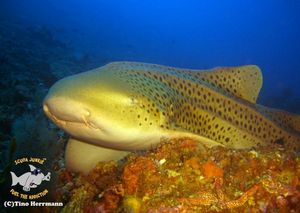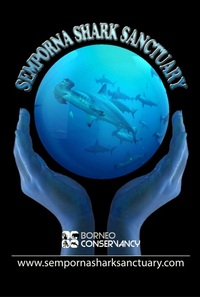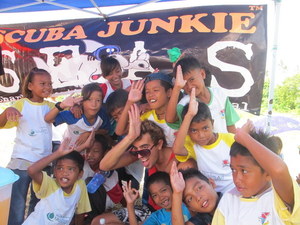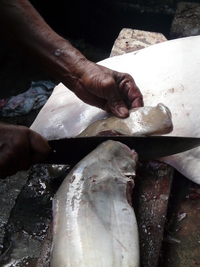Fiona Childs reports on the proposed Semporna Shark Sanctuary that is designed to increase eco-tourism opportunities while protecting sharks and rays. A Gaia Discovery exclusive.

Sharks are an integral part of the marine eco-system but the population of many species are rapidly declining.
Semporna, 20 April 2013. The Semporna region on the east coast of Malaysian Borneo comprises 83 islands and reefs. It is part of the Coral Triangle, a wildlife enriched area spanning the seas bound by Malaysia, Indonesia, the Philippines, West Papua and to the far east Timor-Leste and Solomon Islands. Within the high level of marine biodiversity that can be found here, 63 species of sharks exist including the rare and elusive Borneo shark, the largest fish in the sea – the whale shark, thresher shark and the scalloped hammerhead shark. It is an area known for world class diving, yet these animals are under serious threat from overfishing.
A cluster of organisations has come together in Sabah to thwart these threats to marine life by collective action. This primarily involves crafting the formation of a demarcated area primarily to protect sharks. The proposed Semporna Shark Sanctuary would protect and preserve these animals and the diversity of the coral reef systems in the designated 8,000 square kilometres and provide sustainable income to alleviate poverty in the region.
The Making of the Semporna Shark Sanctuary

The proposal for a shark sanctuary in Semporna, Sabah awaits the approval from the authorities. In the meantime, sharks continue to be overfished in many areas.
Work began on the Semporna Shark Sanctuary proposal in 2009 and considerable progress has been made to date. Borneo Conservancy, a local social enterprise, submitted a formal proposal on the sanctuary to the authorities. This received considerable support from the local government and the Department of Fisheries, according to Rohan Perkins, the Environmental Officer with Scuba Junkie Dive Centre.
“Local and international non-governmental organisations and dive operators have backed the project and over 50,000 people have since signed the petition,” he told Gaia Discovery. A Shark Alliance has been formed consisting of Malaysia Nature Society – Sabah Branch (MNS-S), Marine Conservation Society (MCS), Shark Education Awareness and Survival (SEAS), Scubazoo, (an underwater filming and photography company), Tropical Research and Conservation Centre (TRACC) and WWF Malaysia. “Together the supporters are working to get the proposal officially accepted and made federal law,” Rohan said.
According to Rohan, the proposal outlines specific fishing practices that are to be permitted such as subsistence fishing, while outlawing commercial fishing within the range. “These would refer to large fishing vessels using methods such as purse seines and long lines to snag indiscriminately hundreds of fish and marine life such as turtles,” he said. Legislation is thus required to enforce protection against these rampant destructive methods that also include dynamite bombing and cyanide fishing. Shark fishing and finning will also be banned. With the acceptance of the proposal, law will back any enforcement that will be needed to act against such unlawful fishing.

Bajau children and others on Mabul island are educated regularly on looking after land and marine environment.
By reaching out, Scuba Junkie’s team of conservationists have garnered the support of local communities to protect the area, in particular sharks. Scuba Junkie, a dive centre and resort on Mabul Island, holds regular presentations on shark conservation at their premises, official and community venues such as schools. Fund raising for the set up of the Semporna Shark Sanctuary has been made possible by contributions from Project Aware, Hearts for Sharks, individual donations as well as on-going T-shirt sales by Scuba Junkie. “A hundred percent of the proceeds go to the sanctuary,” exclaimed Rohan.
Benefits of the Semporna Shark Sanctuary
Marine tourism, eco tourism, snorkel and dive operations provide livelihood through employment to local communities within its boundary. Fishing communities, which would otherwise suffer with the decline of these species, will be compensated through employment opportunities created in the maintenance, up keep and protection of the sanctuary. Many tourists state that sharks are the major reason they visit the area. According to Dr James Alin from University Malaysia Sabah’sSchool of Business of Economics, Sabahdiving brings in around RM195 million per year (US$65 million) to the economy whereas banning shark fishing would mean a comparatively small loss of RM5 million (US$1.67 million) to the industry.

Sharks when alive provide more income for villagers and communities through eco tourism and marine tourism.
Globally, according to the International Union for Conservation of Nature, a third of all shark species are nearly extinct and some species of sharks such as the hammerhead have declined by up to 90% in the last 50 years, primarily as a result of the shark fin trade. Many of the species targeted are apex predators, they maintain prey diversity and without them marine ecosystems have been shown to collapse.
In local fish markets, Manta Trust, a research based conservation organisation, found many juvenile and near term pregnant sharks showing that the region is potentially an important breeding and pupping area. As well as protecting reef habitats and open water where pelagic sharks roam, it would also cover mangroves – vital nursery areas. More research is needed; camera and tagging data would help to record numbers and determine whether sharks in the area are semi resident or migratory.
More Work Ahead for Sanctuary Champions

Rohan Perkins of Scuba Junkie gives talks to spread the message that sharks are safe and need our protection.
When I visited Scuba Junkie for a review in April this year, I also attended a presentation delivered by Rohan on sharks and shark conservation to the local tourism authorities as well as guest divers. Scuba Junkie, in partnership with other dive centers and resorts on Mabul, engages with the islanders in education and awareness activities through events such as Mabul Marine Week, an event that began six years ago with the participation of dive operators on the island and rotating chairmanship. For the last three years, Scuba Junkie has been chairing the initiative, which has garnered the support of local authorities as well.
Mabul island communities are amix of settlers from indigenous Sabah tribes with influences from neighbouring Philippines migrants and the Bajau – or stateless people - fringing a section of the beach, living in abject poverty. They are all invited to the fun filled conservation activities as well, opening up new worlds of knowledge of the treasures of the underwater world. Many have since turned away from the use of homemade bombs after learning about their destructiveness to marine life ecosystems. Still there’s more education to be done, as I heard bombs going off in the distance when diving off the protected Sipadan Island in April this year.
Some businesses and restaurants in Semporna, Kota Kinabalu (the capital city of Sabah) and Kuala Lumpur (the administrative centre of Malaysia) now back the proposed shark sanctuary. According to Rohan, results are apparent. “On Mabul island there used to be ‘stations’ where a catch of 50-60 sharks could be seen with their fins being removed as often as three or four times a week. This is no longer the case,” he said.
Despite effects on numbers due to over fishing, a number of shark species are still encountered on a daily basis in Sabah and Semporna. This makes it the ideal location for a protected area as it is still possible to prevent their decline instead of having to 'reintroduce and rehabilitate'. The Semporna Shark Sanctuary, when implemented, would be South East Asia’s first, with the potential to set a model for more through demonstrating successful conservation and economic development.
The Semporna Shark Sanctuary Petition
Notes and References:
IUCN, International Union for Conservation of Nature
http://cmsdata.iucn.org/downloads/summary_of_report.pdf
Semporna Shark Alliance:
Malaysia Nature Society – Sabah Branch (MNS-S)
Visit their Facebook
Marine Conservation Society (MCS)
Unit 3, Wolf Business Park, Alton Road, Ross-on-Wye, Herefordshire HR9 5NB, UK
Visit their Facebook
Shark Education Awareness and Survival (SEAS), Scuba Junkie
G23, Wisma Sabah, Kota Kinabalu 88000, Sabah, Malaysia
https://www.facebook.com/scubajunkiesipadan/
Tropical Research and Conservation Centre (TRACC)
4 Turtle Beach, Pom Pom Island, Semporna, Sabah, Malaysia
https://www.facebook.com/tracc.borneo
WWF Malaysia
6th Floor , CPS Tower ,Centrepoint Complex , No 1, Jalan Centrepoint , 88000 , Kota Kinabalu , Sabah , Malaysia
https://www.facebook.com/wwfmy
Comparison of economic value of sharks through ecotourism and fishing:
https://www.sharksavers.org/en/education/the-value-of-sharks/sharks-and-ecotourism/
Reasons for Semporna Shark Sanctuary
http://www.newsabahtimes.com.my/nstweb/fullstory/60669